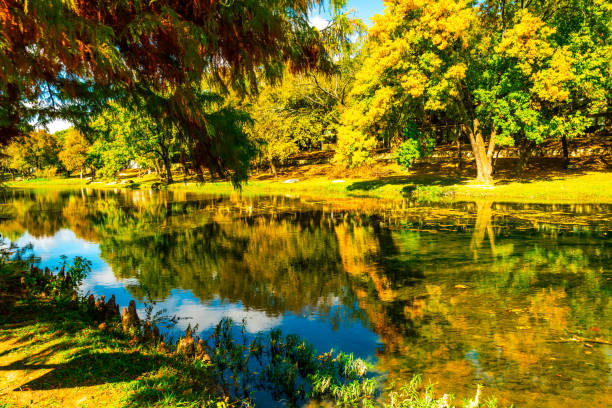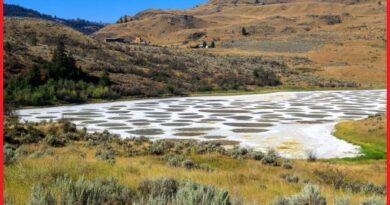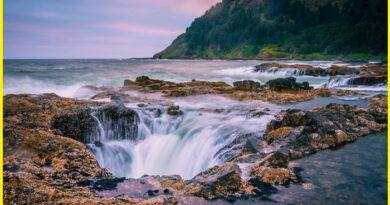“Lakeside Escapes-Discovering Texas’ Finest Lakes”
Best Lakes in Texas
Texas boasts a variety of beautiful lakes, each offering its own unique features and recreational opportunities. Lakes are large bodies of water surrounded by land and are typically inland, though there are some exceptions such as Great Salt Lake in Utah, which is technically a saltwater lake. Lakes can form through various geological processes, such as glaciation, volcanic activity, tectonic activity, or erosion. Glacial lakes, for example, are formed by the melting of glaciers, while volcanic lakes form in the craters of volcanoes. Some of the best lakes in Texas include-
Lake Travis
Lake Travis is one of the largest and most popular reservoirs in Texas, located northwest of Austin in the Texas Hill Country. Lake Travis is situated primarily in Travis County, Texas, with parts extending into Burnet and Llano counties. It is approximately 20 miles northwest of downtown Austin.
The lake covers approximately 18,929 acres when full and has a shoreline length of about 270 miles. Its maximum depth is around 210 feet. Lake Travis was formed in 1942 by the construction of Mansfield Dam on the Colorado River, primarily for flood control and water supply purposes. The lake is named after William Barret Travis, the commander of the Republic of Texas forces at the Battle of the Alamo.
Lake Travis offers a wide range of recreational activities, including boating, fishing, swimming, waterskiing, wakeboarding, kayaking, and paddleboarding. Several marinas, boat ramps, and parks around the lake provide access to these activities. Popular spots for boating include Devil’s Cove, Starnes Island, and Sandy Creek. Several parks and attractions surround Lake Travis, such as Pace Bend Park, Windy Point Park, Hippie Hollow Park (clothing-optional), and the Oasis on Lake Travis, a renowned restaurant and sunset-watching spot.
Lake Buchanan
Lake Buchanan is one of the largest and northernmost lakes in the Highland Lakes chain, located in the Texas Hill Country. Lake Buchanan is situated in central Texas, primarily in Burnet County. It is approximately 60 miles northwest of Austin and about 95 miles north of San Antonio. Lake Buchanan covers approximately 22,333 acres when full and has a shoreline length of about 124 miles. Its maximum depth is around 132 feet.
Also Read- Hamilton Pool Preserve-A Famous Sink Hole in Austin, Texas
Lake Buchanan was created in the 1930s with the construction of Buchanan Dam on the Colorado River. The dam was built as part of a series of projects aimed at flood control, hydroelectric power generation, and water supply for central Texas. Surrounding Lake Buchanan are several parks and attractions, including Inks Lake State Park, Longhorn Cavern State Park, and the Vanishing Texas River Cruise, which offers scenic boat tours of the lake and the Colorado River.

Lake Buchanan offers a variety of recreational activities, including boating, fishing, swimming, kayaking, and birdwatching. The lake is known for its fishing opportunities, with anglers targeting species such as white bass, striped bass, catfish, and crappie. Several marinas, boat ramps, and parks provide access to the lake.
Lake Texoma
Lake Texoma is a large reservoir located on the border of Texas and Oklahoma, formed by the impoundment of the Red River by Denison Dam. Lake Texoma spans across both Texas and Oklahoma. The southern portion of the lake lies in Grayson County, Texas, while the northern portion extends into Bryan County, Oklahoma. It is situated approximately 75 miles north of Dallas and 121 miles southeast of Oklahoma City.
Lake Texoma is one of the largest reservoirs in the United States, covering approximately 89,000 acres when full. It has a shoreline length of over 580 miles, making it a significant recreational destination in the region. Lake Texoma was created in the 1940s with the construction of Denison Dam, a project undertaken for flood control, hydroelectric power generation, and water supply purposes. The damming of the Red River resulted in the formation of the expansive reservoir.
Surrounding Lake Texoma are numerous parks and attractions, including Eisenhower State Park in Texas and Lake Texoma State Park in Oklahoma. These parks offer amenities such as camping, hiking trails, picnicking areas, and scenic overlooks. Like many reservoirs, Lake Texoma’s water levels can fluctuate significantly due to changes in rainfall and water release schedules. The lake is managed by the U.S. Army Corps of Engineers, which regulates water levels based on various factors, including flood control, water supply, and environmental considerations.
Toledo Bend Reservoir
Toledo Bend Reservoir is a massive reservoir located on the border between Texas and Louisiana, formed by the impoundment of the Sabine River by the Toledo Bend Dam. Toledo Bend Reservoir spans across both Texas and Louisiana. The southern portion of the reservoir lies in Sabine Parish, Louisiana, while the northern portion extends into Newton, Sabine, and Shelby counties in Texas. It is situated approximately 65 miles northeast of Beaumont, Texas, and 35 miles southwest of Many, Louisiana.
Toledo Bend Reservoir is one of the largest man-made reservoirs in the United States, covering approximately 185,000 acres (288 square miles) when full. It has a shoreline length of over 1,200 miles, making it a significant recreational destination in the region.
Toledo Bend Reservoir was created in the 1960s with the construction of the Toledo Bend Dam, a joint project undertaken by the states of Texas and Louisiana for flood control, hydroelectric power generation, and water supply purposes. The damming of the Sabine River resulted in the formation of the expansive reservoir.
Possum Kingdom Lake
Possum Kingdom Lake is a picturesque reservoir located in North Texas, known for its clear blue waters, rugged cliffs, and scenic beauty. Possum Kingdom Lake is situated primarily in Palo Pinto County, Texas, approximately 80 miles west of Fort Worth. It is nestled within the Palo Pinto Mountains and lies along the Brazos River. Possum Kingdom Lake covers approximately 17,000 acres when full, with a shoreline length of about 310 miles. Its maximum depth is around 145 feet.
Possum Kingdom Lake was created in the 1940s with the construction of Morris Sheppard Dam on the Brazos River. The dam was built for hydroelectric power generation, flood control, and water supply purposes. The resulting reservoir, Possum Kingdom Lake, has since become a popular recreational destination.
Canyon Lake
Canyon Lake is a stunning reservoir located in the Texas Hill Country, known for its clear blue waters, rugged limestone cliffs, and scenic surroundings. Canyon Lake is situated primarily in Comal County, Texas, approximately 40 miles north of San Antonio and 50 miles southwest of Austin. It is nestled within the rolling hills and canyons of the Texas Hill Country.
Canyon Lake covers approximately 8,230 acres when full, with a shoreline length of about 80 miles. Its maximum depth is around 125 feet. Canyon Lake was created in the 1960s with the construction of Canyon Dam on the Guadalupe River. The dam was built for flood control, water supply, and hydroelectric power generation purposes. The resulting reservoir, Canyon Lake, has since become a popular recreational destination.
Canyon Lake offers a wide range of recreational activities, including boating, fishing, swimming, waterskiing, wakeboarding, hiking, and camping. The lake is known for its excellent fishing opportunities, with popular catches including largemouth bass, striped bass, catfish, and sunfish. Several marinas, campgrounds, and parks around the lake provide access to these activities. Surrounding Canyon Lake are several parks and attractions, including Canyon Lake Gorge, a geological wonder carved by the floodwaters of the Guadalupe River. The lake is also home to Canyon Lake Marina, Overlook Park, and numerous hiking trails offering scenic views of the surrounding landscape.
Best Lakes in Texas to live on
Living on a lake in Texas can offer a tranquil lifestyle with access to water-based activities and stunning views. When considering the best lakes in Texas to live on, several factors come into play, including the quality of life, amenities, affordability, and proximity to urban centers.
Situated close to downtown Austin, Lake Austin provides a convenient location for those who enjoy city amenities but desire a waterfront lifestyle. Living on Lake Austin offers access to boating, fishing, and waterfront dining while being just a short drive from the vibrant culture and entertainment of Austin.
With its expansive shoreline and scenic Hill Country backdrop, Lake Travis is a popular destination for lakefront living. Communities around Lake Travis offer a range of housing options, from luxurious waterfront estates to cozy lakeside cottages. Residents can enjoy boating, water sports, golfing, and dining at waterfront restaurants.
When choosing a lake to live on in Texas, it’s essential to consider factors such as water quality, property taxes, homeowners association fees, flood risk, and access to essential services. Additionally, visiting potential lakefront communities and speaking with local residents can provide valuable insights into the lifestyle and amenities offered by each lake.
Best Lakes in Texas to Swim
When it comes to swimming in Texas, several lakes offer excellent opportunities for enjoying the water in a safe and enjoyable environment. While not a traditional lake, Hamilton Pool Preserve near Austin is a natural pool formed by a collapsed underground river. Its crystal-clear waters and picturesque waterfall make it a popular spot for swimming and cooling off during hot Texas summers. However, access to Hamilton Pool Preserve requires reservations due to its popularity and limited capacity.
Another natural swimming spot, Blue Hole in Wimberley, Texas, offers clear, spring-fed waters perfect for swimming. Surrounded by lush vegetation, Blue Hole provides a refreshing escape from the summer heat. Like Hamilton Pool Preserve, Blue Hole has limited capacity and may require reservations during peak times.
Located within Zilker Park in Austin, Barton Springs Pool is a beloved swimming destination fed by natural springs with a constant temperature of around 68 to 70 degrees Fahrenheit (20 to 21 degrees Celsius) year-round. This three-acre pool is popular among locals and visitors alike for its clean waters and scenic surroundings.
Best Lakes in Texas for Vacation
Choosing the best lake in Texas for a vacation depends on your preferences for activities, scenery, and amenities. Known for its stunning Hill Country scenery and abundance of recreational activities, Lake Travis is an excellent choice for a vacation. You can enjoy boating, water skiing, fishing, swimming, and even zip-lining over the lake. There are also waterfront restaurants, marinas, and resorts along the shoreline, offering a range of accommodation options.
As the largest of the Highland Lakes, Lake Buchanan offers a more tranquil setting for a relaxing vacation. You can rent a lakefront cabin or stay at a lakeside resort and spend your days fishing, kayaking, birdwatching, or simply enjoying the scenic beauty of the area.
Straddling the Texas-Oklahoma border, Lake Texoma is a massive reservoir known for its excellent fishing and water sports opportunities. You can rent a cabin or book a vacation rental along the shoreline and spend your days boating, fishing, swimming, or exploring nearby attractions such as state parks and wildlife refuges.
Best Lakes in Texas for Lake House
When selecting a lake in Texas for a lake house, you’ll want to consider factors such as the quality of the lake, available amenities, proximity to services, and the overall ambiance of the area. Located near Austin, Lake Travis is a popular destination for owning a lake house due to its scenic beauty, clear waters, and abundant recreational opportunities. Lake Travis offers a wide range of waterfront properties, from cozy cabins to luxurious estates, along with amenities such as marinas, waterfront restaurants, and golf courses.
Just north of Houston, Lake Conroe offers a convenient location for owning a lake house with easy access to urban amenities. Lakefront properties around Lake Conroe provide opportunities for boating, fishing, water skiing, and other water sports, as well as access to golf courses, shopping centers, and restaurants.
Part of the Highland Lakes chain, Lake LBJ is a popular destination for owning a lake house in the Texas Hill Country. Lakefront properties on Lake LBJ offer scenic views, calm waters ideal for boating and swimming, and access to amenities such as golf courses, resorts, and waterfront dining.

Best Lakes in Texas for Boating
Texas is home to numerous lakes that offer fantastic opportunities for boating enthusiasts. Located near Austin, Lake Travis is one of the most popular lakes in Texas for boating. With its expansive surface area and clear waters, Lake Travis provides ample space for all types of boating activities, including sailing, powerboating, waterskiing, wakeboarding, and kayaking. The lake also features several marinas, boat ramps, and waterfront restaurants.
Straddling the Texas-Oklahoma border, Lake Texoma is one of the largest reservoirs in the United States and a paradise for boating enthusiasts. Boaters can explore the lake’s vast expanse, which spans over 89,000 acres, and enjoy sailing, powerboating, fishing, and watersports. Lake Texoma features several full-service marinas, boat ramps, and camping areas.
As one of the Highland Lakes in central Texas, Lake Buchanan offers excellent boating opportunities in a scenic Hill Country setting. Boaters can cruise along the lake’s winding shoreline.
How to Reach Texas
Texas is served by several major airports, including Dallas/Fort Worth International Airport, George Bush Intercontinental Airport in Houston, and Austin-Bergstrom International Airport. These airports offer domestic and international flights, making air travel a convenient option for reaching Texas from anywhere in the world.
If you’re traveling from nearby states or regions, driving to Texas is a popular option. Texas is well-connected to neighboring states via interstate highways, including I-10 from the west, I-20 from the east, I-35 from the north, and I-45 from the south. The state’s extensive highway network makes it accessible by car from various directions.
Several bus companies, such as Greyhound and Megabus, provide intercity bus services to major cities in Texas, including Dallas, Houston, San Antonio, and Austin. These services offer an affordable alternative for travelers who prefer not to drive.
Amtrak operates train services to major cities in Texas, including the Texas Eagle route, which connects Chicago to San Antonio with stops in cities such as Dallas and Fort Worth. While train travel may take longer than other modes of transportation, it offers a scenic and relaxing way to reach Texas.



